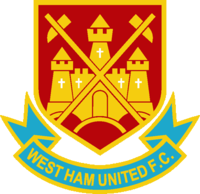Reading the local newspaper, "Ouest France", today, whilst overlooking the expanse sandy beach of Val Andre (West France), before scoffing a baguette coated in local honey, I found on the back page this "L'Image" (below) of an ancient ritual played out in the town of Bourton-on-the Water, Gloucestershire. Translate the headline!
During the summer, a game of medieval football is played with goal posts set up in the River Windrush. These days, two teams play with a standard football and a referee who attempts to keep order. Crowds line the banks of the river and the aim is to score as many goals as possible (while getting everyone else soaking wet).The original game would not have had goals but something like a tree/bush/door? on the river banks to aim for and an inflated pig's bladder in place of the not yet invented, inflated, leather-coated ball. Somtimes, the mob gamesters would travel across miles of local landscape, up hill and down dale to reach their "goal"; a church door or a memorial pillar. Mob football is an ancient game, played by the Romans, Greeks, anybody! and it is believed to be the ancestor for all codes of modern football, well it would be, wouldn't it?
The sport was usually contested between two neighbouring towns, with as many participants as can be, on each side. These archaic forms of football would be played on "ceremonial days", involving an unlimited number of players on opposing teams, who would clash in a heaving scrum of people struggling to drag an inflated pig's bladder by any means possible to markers (goals?) at each end of a town or indeed in the next settlement. The village of Bourton, has its own non-league football club, Bourton Rovers, founded in 1894, who play at the Rissington Road ground in the west of England, Hellenic League.
There is also a model village in Bourton, a 1:9 replica of the village and includes a model of the model village itself. (get that?) It was built by local craftsmen in the 1930s, and opened in 1937. The model village was awarded Grade 2 listed status in 2013 in recognition of its uniquely precise details and the genuine building materials and methods used, which replicate those used in the construction of the life-size village. There is of course a "standard" model railway to go with it. There is the Cotswold Motor Museum (home of Brum- a children's TV series), a Birdland Park, which unsurprisingly, has a collection of birds, including parrots, penquins and passerine (perching) birds and a large pond full of salmon which can be fed by the public. There are bird of prey displays and a penguin feeding demonstration. Don't miss the The Dragonfly Maze, the monthly farmers' market and by the way, the Oasis' music video, "I'm out of time" was recorded in the town, and shows Liam Gallagher walking in the countryside of the local area, in the model village and around the town. The long distance footpath, "The Heart of England Way" will lead you to other footballing venues in the vibrant English Midlands. Staycation???? During, last year's Bank Holiday (2020), as social distancing was well into the lives of the Gloucestershire folk, something had to give. Instead of the customary 11am ko, two teams from the local club, kicked off (splashed off?) at 7am, avoiding a big crowd and perhaps the local "Bobby" wouldn't have risen by then to issue "fines". There was a hint of fancy dress and actually not too many lads/lassies were out at that time in the morning. Bank Holiday hangover? A collection was held to raise money for the club. As a tourist attraction, starting at a sensible time, when the sun was well up, approximately 10,000 spectators would have turned up to see a bunch a locals wade through the "Water" and try to score in what were "modern goals", which rather spoilt the authenticity. But at least the occasion took place, midst the unprecedented Covid thing. Quite proud to use that word.....unprecedented.....done it again! I guess the local businesses will have lost out on a tourist cash, but there is always the next year. Below is a previous blog dealing with "mob football"
During, last year's Bank Holiday (2020), as social distancing was well into the lives of the Gloucestershire folk, something had to give. Instead of the customary 11am ko, two teams from the local club, kicked off (splashed off?) at 7am, avoiding a big crowd and perhaps the local "Bobby" wouldn't have risen by then to issue "fines". There was a hint of fancy dress and actually not too many lads/lassies were out at that time in the morning. Bank Holiday hangover? A collection was held to raise money for the club. As a tourist attraction, starting at a sensible time, when the sun was well up, approximately 10,000 spectators would have turned up to see a bunch a locals wade through the "Water" and try to score in what were "modern goals", which rather spoilt the authenticity. But at least the occasion took place, midst the unprecedented Covid thing. Quite proud to use that word.....unprecedented.....done it again! I guess the local businesses will have lost out on a tourist cash, but there is always the next year. Below is a previous blog dealing with "mob football"
https://www.blogger.com/blog/post/edit/3994718670252035536/2283954334996156101

https://www.youtube.com/watch?reload=9&v=MaMEHdyKXR4 video dated 2014































